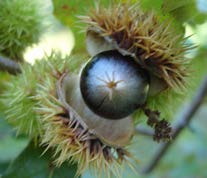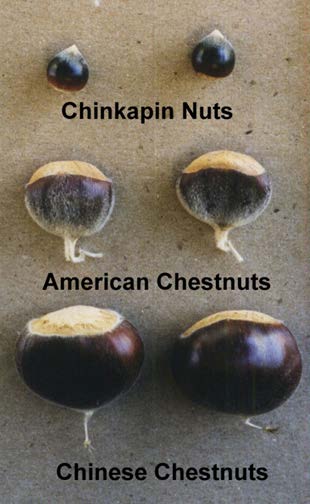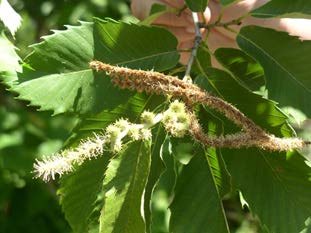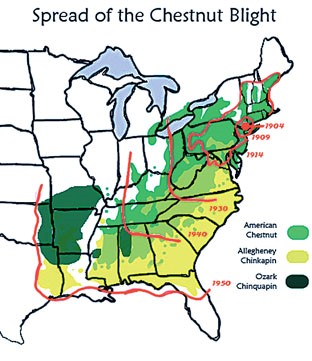AgEBB-MU CAFNR Extension
Green Horizons
Volume 22, Number 3
Fall 2018
Species Spotlight
Species Spotlight: The Ozark Chinquapin
Michael Gold| University of Missouri Center for Agroforestry
 |
Ozark chinquapin single nut in bur |
The Ozark chinquapin (Castanea ozarkensis), sometimes called Ozark chestnut or chinkapin, is a drought tolerant hardwood tree that once grew up to 65' in height and up to 3' in diameter. The Ozark chinquapin is closely related to the American chestnut (Castanea dentata) and the Allegheny chinquapin (Castanea pumila) found further north and east.
 |
Size comparison of chinkapin, American, and Chinese chestnuts |
 |
Ozark chinquapin male catkin and female flower (at base of catkin) |
The blight spread throughout the natural range of the American chestnut from ~1900-1940, and eventually reached the Ozarks in the 1960's. Within a decade, the Ozark hills were littered with the carcasses of Ozark chinquapin trees that reached up to 60 feet high. Today, the chinquapin survives mostly as root suckers that re-sprout after the above-ground portion of the tree is killed, and therefore very few seeds are produced to re-populate the species.
Ozark chinquapin restoration efforts are currently led by the Ozark Chinquapin Foundation (OCF) https://ozarkchinquapinmembership.org/. OCF efforts include:
- locating blight resistant trees
- distribute resistance seed for growing
- cross pollination
- DNA Analysis to confirm pure native strands
- nut grafting/twig grafting
- establishing research farms
 |
Spread of the Chestnut Blight. Credit: Ozark Chinquapin Foundation |
This restoration work is a collaborative effort involving University researchers, student volunteers, local, State, and Federal cooperators, as well as outdoorsmen and women participating in field research and education. The Center for Agroforestry, in conjunction with the Missouri Dept. of Conservation, is becoming more involved in the overall restoration effort and will be an active partner in coming years.
Sources: Ozark Chinquapin Foundation, Missouri Botanical Garden
